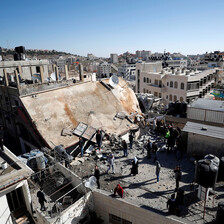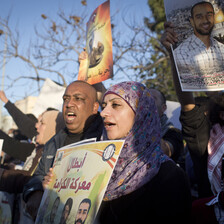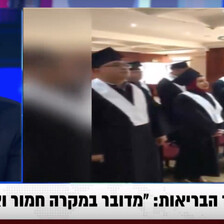The Electronic Intifada 7 July 2016
For the past three years, shellings and airstrikes have been a reality for the residents of Khan Eshieh refugee camp near Damascus.
But the intensity of shelling on the camp in the past two months is unprecedented even by that standard.
The Palestinian camp has come under greater fire amid an escalation of fighting between Syrian government forces, backed by Russian airstrikes, and various Islamist rebel groups in the Damascus countryside. Several civilians in the camp were killed in June.
“Russian warplanes targeted the camp with cluster bombs and missiles on Thursday, killing six people and causing massive destruction,” Emad al-Muslimani from Khan Eshieh told The Electronic Intifada via Skype. “Civilians are the target. There are about 2,000 families trapped in the camp with nowhere to go.”
The two days of relative quiet that followed the 30 June shelling proved to be only a temporary reprieve. Airstrikes on Sunday night killed three residents and resulted in the destruction of a community center for children run by the Jafra Foundation, a volunteer group that works in Syria’s Palestinian refugee camps.
A host of problems
Al-Muslimani, a 31-year-old citizen journalist and member of the Khan Eshieh local council, says those who remain in the camp are civilians.
“Most of those in the camp are either children and the elderly or those waiting for family unification as they have relatives in Europe,” he said.
Save the Children stated in May that an estimated 3,000 children currently live under near-total siege there.
According to al-Muslimani, residents of the camp face several acute problems in addition to the daily shelling and the overall dire situation. They are living through a sweltering summer with only four to six hours of electricity per day.
The last remaining open road out of the camp, known locally as the “road of death,” is constantly targeted by snipers. The road is a flashpoint for clashes between government and rebel forces and if it is seized by the government, it would put the camp under complete siege.
It’s via this road that residents go to their jobs in the Syrian capital or get fuel, flour and medicine from the nearby village of Zakia. But even going to receive medical treatment or run a simple errand can become a life-threatening proposition.
What basic goods enter the camp are sold at such high prices that most residents cannot afford them if not for the help of local charities and humanitarian organizations.
Located approximately 15 miles southwest of Damascus near the highway connecting the Syrian capital to Quneitra, Khan Eshieh is the Palestinian refugee camp in Syria closest to Palestine.
Older residents of the camp, according to those who have fled and now reside in Lebanon, have never relinquished the dream of return, and continue to maintain they are a heartbeat away from home.
They still hope that once Palestine is liberated, refugees from Khan Eshieh would be the first to make their way home. They take pride in the camp lore that the late Palestinian leader Yasser Arafat, a hugely popular figure in the camp, reportedly named Khan Eshieh the “camp of return.”
Bedouin traditions
Khan Eshieh camp, named after the Syrian town next to it, was established by UNRWA, the United Nations agency for Palestine refugees, in 1949. The camp was set up to serve those who had fled of were forced to flee northern Palestine the year prior, when their country was overrun by Zionist militias and some 750,000 Palestinians were displaced. The dispossession of Palestine during that period is known as the Nakba or catastrophe.
The vast majority of the camp’s residents hail from Bedouin tribes that lived in the Galilee region, a background that has left an unmistakable trace on the camp’s social fabric.
Not only was the camp divided across tribal lines, with streets named after the tribes that resided in them, but many of the camp residents, even those born in Syria, still retain the Bedouin accent.
The tents that were initially set up in the camp were later replaced by houses made of clay before unregulated construction began to dominate in the last three decades. Natural growth in the camp meant it had to expand beyond the small area designated for it by UNRWA.
The Palestinian residents of the camp needed little time to form strong ties with neighboring Syrian villages and towns in the western Ghouta area, say residents who have fled the fighting and now reside in Lebanon. For many years, the camp was the only place in that rural area with a functioning education system.
“The UNRWA-run schools in the camp drew kids from neighboring Syrian towns who came to Khan Eshieh to study,” Palestinian poet Raed Wahsh, who was born and raised in Khan Eshieh, told The Electronic Intifada.
“And later when public schools were established in those villages, it was mainly teachers from Khan Eshieh who taught there,” he added. “Khan Eshieh provided its Syrian neighbors with education twice: first through its schools, and later through its teachers.”
The camp operated both as a trade center and market for neighboring towns and provided them with a significant workforce in the local agriculture sector.
More freedom
In Syria, where civil and political liberties are sharply circumscribed, Palestinian camps had a slightly wider margin for political organizing, as long as they refrained from criticizing the government.
Yasser Arafat’s Fatah party was long banned by the Syrian government, but other Palestinian factions were allowed to open offices in the camp. The last decade witnessed a rise in the influence of Hamas in the camp as a growing tide of political Islam swept the region.
“Hamas provided aid and charity for those in need and used that, in addition to its close relations with the Syrian regime back then, to establish itself as the main political force in the camp,” Wahsh said. “In fact, Khan Eshieh was also a microcosm for the divisions among Palestinian factions and especially the Fatah-Hamas split.”
Divisions notwithstanding, Khan Eshieh clung to its strong sense of community. Residents maintained their penchant for telling and sharing stories, not without sprinkling in the necessary political flavor.
Wahsh authored A Missing Piece from the Damascus Sky, a prose book published in 2013, offering a glimpse into the lesser known refugee camps of Damascus. Through a mixture of fact and fiction, the book narrates the stories of the camp’s heroes and villains, dealing with individual grief and collective transformation after the Syrian conflict erupted in 2011.
By 2011, Khan Eshieh was home to 20,000 refugees registered with UNRWA, as well as many Syrians, and the total population was believed to be 25,000. That figure almost quadrupled, say residents, by the start of 2012, as people displaced by the fighting in the country sought shelter in the camp.
When popular protests broke out in the country in early 2011 and were repressed with lethal force by the government, war followed, and Palestinian camps in Syria, including Khan Eshieh, were keen to remain outside the fighting.
While walls in the camp did see some anti-government graffiti during the early phases of the uprising, Palestinian political factions and civil groups agreed that it was important for the camp as a whole to stay neutral, according to accounts by former residents now living in Lebanon.
Another Nakba?
Like several Palestinian camps in Syria, most notably Yarmouk refugee camp, Khan Eshieh offered a safe haven for internally displaced Syrian families.
“Khan Eshieh welcomed displaced people from Darayya, Muadamiyat al-Sham, Yarmouk refugee camp and other areas that witnessed clashes,” Rafiq Hadi, an activist from Khan Eshieh now based in Beirut, told The Electronic Intifada. “Our camp represented a rare model of solidarity and peaceful organizing that belied its small size and limited resources.”
The influx of displaced families led Syrian government forces to set up a checkpoint in 2012 where camp residents were repeatedly harassed and humiliated, according to Hadi. The checkpoint was removed after coming under fire from opposition factions active in the vicinity. The government, however, maintained a military outpost at the outskirts of the camp.
“Khan Eshieh’s own Nakba commenced on 13 March 2013, a day known by residents as Bloody Wednesday,” Hadi, a cofounder of a media center covering Palestinian refugee issues, said. On a day of intense shelling that killed a teacher employed by UNRWA as he and his family tried to flee, Hadi said the situation in Khan Eshieh changed dramatically.
“Opposition groups attacked the [army] outpost and seized it,” Hadi said.
Government forces responded by shelling the camp, causing a mass exodus. But those that remained were determined to stop the camp from being taken over by armed groups, say former residents. Local groups clashed with Islamist militias when the latter tried to control the camp and turn it into a base.
Residents eventually forced them out. A civil committee was set up to manage camp affairs. Issues relating to education, aid and relief are now mainly addressed by local civil society groups. But while these efforts were successful — fighters affiliated with rebel groups are now concentrated in farms near the camp, not the camp itself — this has not protected the camp from bombing.
Khan Eshieh has reportedly been one of the areas in Syria most afflicted by the government’s crude barrel bombings. Combined, airstrikes and barrel bomb attacks have caused the destruction of nearly 20 percent of the camp’s buildings, according to Hadi.
“Khan Eshieh has returned to the drawing board after the shrinking of its area and population,” Raed Wahsh said. “There is an attempt to erase the camp because the camp is an embodiment of the right of return and the commitment to Palestine.”
Elderly residents of the camp, who harbor memories of their expulsion from Palestine in 1948, are living the Nakba again. Some seventy years later, they bear witness to another chapter of uprooting and displacement.
Palestine will never be as close, as touchable, if Khan Eshieh is lost.
Budour Youssef Hassan is a Palestinian writer and law graduate based in occupied Jerusalem. Blog:budourhassan.wordpress.com. Twitter: @Budour48




